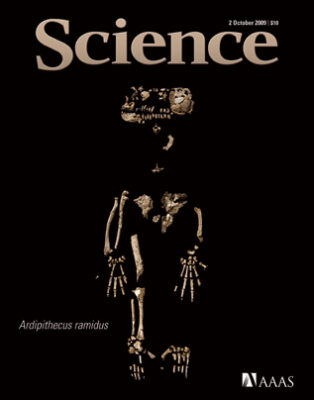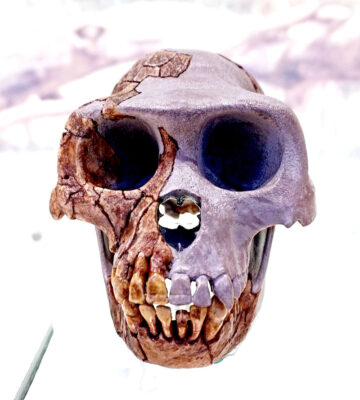 The October 2009 special edition of the journal Science (cover pictured right below) entitled Ardipithecus ramidus, kindly known as “Ardi,” featured a series of 11 papers by 47 authors from 10 countries – launching the Ardipithecus ramidus (pictured left) saga.
The October 2009 special edition of the journal Science (cover pictured right below) entitled Ardipithecus ramidus, kindly known as “Ardi,” featured a series of 11 papers by 47 authors from 10 countries – launching the Ardipithecus ramidus (pictured left) saga.
With an estimated age of 4.4 million years, Ardi is considered the oldest hominid skeleton ever discovered, predating Lucy and casting unexpected clues into the increasingly complex human evolution jigsaw puzzle.
The unexplainable saga, however, actually began nearly 15 years ago.
In 1994, American anthropologist Tim D. White of the University of California, Berkeley, along with Japanese paleoanthropologist Gen Suwa and Ethiopian paleontologist Berhane Asfaw, unearthed the first two pieces of fossilized bone of a hominid hand near the Awash River region of Ethiopia.
Within just a few weeks, with more than 100 additional bone fragments discovered, White and the team began directing one of the most promising searches to unravel the now entangled and long-beleaguered theory of human evolution.
Media Campaign
Brooks Hanson, the executive vice president of the American Geophysical Union (AGU), launched the saga media campaign by writing the Science series introduction. Entitled “Light on the Origin of Man,” Hanson explains –
“Ardipithecus ramidus thus helps us bridge the better-known, more recent part of human evolution.”
Time Magazine, in the article entitled “Ardi Is a New Piece for the Evolution Puzzle” by Michael D. Lemonick, contributed to the natural selection saga by noting –
“The completeness of Ardi’s remains, as well as the more than 150,000 plant and animal fossils collected from surrounding sediments of the same time period, has generated an unprecedented amount of intelligence about one of our earliest potential forebears.”
The Discovery Channel produced a series of videos to present the findings and the implications of Ardi, addressing specifically how Ardi uniquely qualifies as a likely human ancestor in some ways.
John Noble Wilford, a science writer for the New York Times, noted in the article entitled “Fossil Skeleton From Africa Predates Lucy,” an email from David Pilbeam, professor of human evolution at Harvard University, noting that the Ardi skeleton represented –
“‘ A genus plausibly ancestral to Australopithecus [Lucy]’ and began ‘to fill in the temporal and structural space between the apelike common ancestor and Australopithecus.'”
 White (pictured left), however, outlines the problem with the evidence in the article entitled “Ardipithecus ramidus and the Paleobiology of Early Hominids,” noting –
White (pictured left), however, outlines the problem with the evidence in the article entitled “Ardipithecus ramidus and the Paleobiology of Early Hominids,” noting –
“Hominid fossils predating the emergence of Australopithecus have been sparse and fragmentary. The evolution of our lineage after the last common ancestor we shared with chimpanzees has therefore remained unclear.”
The Ardipithecus ramidus saga adds more questions than answers, but the dilemma is not new.
Charles Darwin
Evolution scientists have long puzzled over identifying the succession of hominids giving rise to modern humans. Charles Darwin, in The Origin of Species, side-stepped the dilemma with the promise –
“In the future, I see open fields for far more important research… Much light will be thrown on the origin of man and his history.”
In The Descent of Man, however, considering the Neanderthal fossils, Darwin suggested the probable ancestors of modern humans are the African ape, gorilla, and chimpanzee –
“It is therefore probable that Africa was formerly inhabited by extinct apes closely allied to the gorilla and chimpanzee; and as these two species are now man’s nearest allies, it is somewhat more probable that our early progenitors lived on the African continent than elsewhere.”
The Journal of Science, October 2009
The journal Science announced the Ardi discovery as the “breakthrough of the year.” As evidence, the journal published eleven presentations, including an introduction, a video, and a summary overview, along with eight  papers covering the physical aspects of the fossil record and environment. Science’s project was co-director by Tim White, Science correspondent Ann Gibbons (pictured left), along with paleoanthropologist Andrew Hill (pictured right below).
papers covering the physical aspects of the fossil record and environment. Science’s project was co-director by Tim White, Science correspondent Ann Gibbons (pictured left), along with paleoanthropologist Andrew Hill (pictured right below).
In the article entitled “The Ardipithecus ramidus Skull and Its Implications for Hominid Origins,” White points out how the Ardi skull differs from other closely related humanoids –
“The Ardipithecus ramidus skull exhibits a small endocranial capacity (300 to 350 cubic centimeters), the small cranial size relative to body size… Ar. ramidus lacks the broad, anteriorly situated zygomaxillary facial skeleton developed in later Australopithecus… showing that the Mio-Pliocene hominid [Ardi] cranium differed substantially from those of both extant apes  and Australopithecus.”
and Australopithecus.”
Science writer Ann Gibbons, in her paper entitled “A New Kind of Ancestor: Ardipithecus Unveiled,” sees Ardi as something other than a transitional link –
“Even though this species probably lived soon after the dawn of humankind, it was not transitional between African apes and humans. Instead, the skeleton and pieces of at least 35 additional individuals of Ar. ramidus reveals a new type of early hominin that was neither chimpanzee nor human.”
Instead of the “breakthrough of the year,” the Ardipithecus ramidus saga is more like a bust.
The Journal of Science, May 2010
In May of this year, a Time magazine article entitled “Ardi: The Human Ancestor Who Wasn’t,” written by a senior editor at Harvard Business Review, Eben Harrell, points out the developing conflict –
“Two new articles being published in Science question some of the major conclusions of Ardi’s researchers, including whether this small, strange-looking creature is even a human ancestor at all.”
Of the two articles, Esteban E. Sarmiento of The Human Evolution Foundation entitled “Comment on the Paleobiology and Classification of Ardipithecus ramidus” noted –
“Their analysis of shared-derived characters provides insufficient evidence of an ancestor-descendant relationship and exclusivity to the hominid lineage.”
Countering Sarmienti’s point, White in the article entitled “Response to Comment on the Paleobiology and Classification of Ardipithecus ramidus,” replied, noting –
“Sarmiento argues that these characters are not exclusive to hominids, contending that Ardipithecus is too old to be cladistically hominid. His alternative phylogeny, however, is unlikely because it requires tortuous, nonparsimonious evolutionary pathways.”
Darwin’s dilemma intensifies.
Genesis
 The Ardipithecus ramidus saga, rather than fitting in as a critical missing piece of the human evolution puzzle, only compounds the problem. Evidence from the Ardipithecus ramidus, however, is compatible with the Genesis account written by Moses.
The Ardipithecus ramidus saga, rather than fitting in as a critical missing piece of the human evolution puzzle, only compounds the problem. Evidence from the Ardipithecus ramidus, however, is compatible with the Genesis account written by Moses.
Louis Pasteur (pictured left), a French chemist and microbiologist, discovered the principles of vaccination, microbial fermentation, and pasteurization, notes during the Scientific Revolution –
“I see everywhere the inevitable expression of the Infinite in the world; through it the supernatural is at the bottom of every heart.”
Evidence for common ancestry and transitional links underscores why the theory of evolution remains speculative but not scientifically valid.
Ardipithecus ramidus Saga is a Fossil Record article.
Darwin Then and Now is an educational resource on the intersection of evolution and science, highlighting the ongoing challenges to the theory of evolution.
Move On
Explore how to understand twenty-first-century concepts of evolution further using the following links –
-
- The Understanding Evolution category showcases how varying historical study approaches to evolution have led to varying conclusions. Subcategories include –
- Studying Evolution explains how key evolution terms and concepts have changed since the 1958 publication of The Origin of Species.
- What is Science explains Charles Darwin’s approach to science and how modern science approaches can be applied for different investigative purposes.
- Evolution and Science feature study articles on how scientific evidence influences the current understanding of evolution.
- Theory and Consensus feature articles on the historical timelines of the theory and Natural Selection.
- The Biography of Charles Darwin category showcases relevant aspects of his life.
- The Glossary defines terms used in studying the theory of biological evolution.
- The Understanding Evolution category showcases how varying historical study approaches to evolution have led to varying conclusions. Subcategories include –
2020 Update
WIKIPEDIA – Ardipithecus ramidus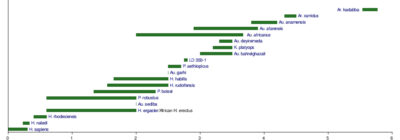
The African hominin timeline graph (pictured right) places Ardipithecus ramidus unconnected to any hominin.
Evolution 101 – Human Evolution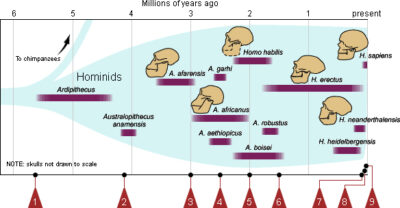
The Human Evolution graph places Ardipithecus the furthest from Homo sapiens and diagrammatically unconnected to any hominin
The Human Family Tree drawing places Ardipithecus the furthest from Homo sapiens and diagrammatically unconnected to any hominin.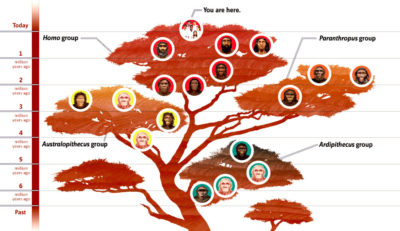
Evolution is a philosophy, not a valid scientific theory

